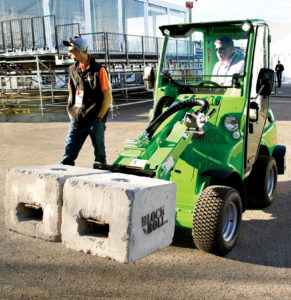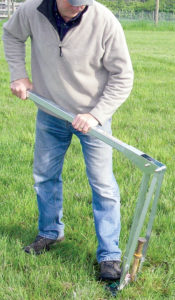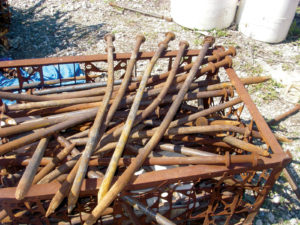
form of Block and Roll blocks) with the Tent
OX system was on display at IFAI Tent
Expo 2017 in Orlando, Fla. Photo courtesy of
B&R Innovations.
Tent professionals are always eager to find ways to make the job of installing tents easier, safer and more efficient. Equipment developed specifically for the tent industry—by the very people who install tents day in and day out—helps achieve these goals.
No one knows who coined the proverb “Necessity is the mother of invention.” Given that tents have existed for ages, it could certainly have been someone struggling with a tent stake thousands of years ago. What we do know is that today, innovations for installation equipment in the tent rental industry are likely to come from someone on the job site identifying a problem and having an “aha!” moment.
Case in point: The world may know New York City as the Big Apple, but the tent industry knows it as “the unstakeable city,” according to Nick Deninno, owner of PTG Event Services, Bethpage, N.Y. As tent installers in New York City and elsewhere were being asked to ballast or weight tents rather than stake them due to underground irrigation and utilities, Deninno recognized the need for a more efficient ballast system that didn’t require heavy machinery. Ballasting is not as simple as staking, and while many operators wanted to do it safely, it often proved to be too difficult.
“They were faced with two options: pass on the job or use something easy like a water barrel, because moving around concrete ballasts was a daunting task and often required heavy equipment to handle it,” he says. Yet, water barrels often fail to provide enough weight to secure a tent.
Deninno watched installers struggle with heavy blocks, barrels filled with concrete and steel plates. And that’s how the Block and Roll® Tent Ballast Solutions® and B&R Innovations LLC, was born. The Block and Roll system allows for easy and safe handling of heavy cement blocks with or without a forklift. The blocks within the system can be stacked for increased weight and easy storage, and the weights have multiple tie-off points for secure tensioning.
“Block and Roll was designed to take the hard work out of ballasting and allow for installers to use heavier blocks as ballast, not always needing a forklift and move the blocks effortlessly,” Deninno says.

Photo courtesy of Construction Accessories.
Tent evolution
The tent rental industry evolved in the late 1980s when tension structures started to replace traditional pole tents. Events were moving off grass and onto blacktop. Corporate events started using new, highly stylized tent designs as the centerpiece of events that previously would have been held indoors. The introduction of ratchets and stake bars allowed stronger anchoring to support tension structures and give them their majestic look.
But tension structures required new installation methods, says Scott Woodruff, founder and owner of Tent OX™ of Enola, Pa. Tent and event companies began adapting single-function products from other industries and applying them to tension structure installations.
“Tent and event companies began to use Bobcat®-type machines and forklifts on job sites,” Woodruff says. “Gas-powered stake drivers began to replace manually swung sledgehammers and hydraulic stake pullers replaced time-consuming and physically exhausting lever pullers.”
These newer tools certainly helped get the tents up, but they weren’t ideal solutions, Woodruff says. “Moreover, the heavy equipment being brought to each site was expensive to transport and operate, and it tended to damage soft surfaces like lawns and paths, so they were often banned by clients.
“Labor costs were rising rapidly at this time, so while companies were working hard, time on site remained high,” he says. “The result? They struggled to clear a meaningful profit on each job.”
In 1987, Woodruff launched an equipment and party rental company, and it was in 2001 that he had the idea for what ultimately became the Tent OX system. Woodruff had just purchased a 60-foot-wide tent and realized that a tent of that size would require almost double the crew.
“I was determined to find a way that wouldn’t require me to make such a large personnel investment,” Woodruff says. “I asked our equipment rental mechanic to help me devise an attachment for the Toro® Dingo® that would allow us to drive the large number of stakes a big tent requires in a fraction of the time it normally takes. And we developed another attachment to eliminate the need for multiple crew members to manhandle the tent’s center pole into place. Once they were constructed, we trained the crew on how to take advantage of the new mechanization.”
Speed, safety and an improved bottom line were the driving forces behind the development of Green Monster Manufacturing, Elmsford, N.Y., which manufactures hydraulic stake pullers and a number of other tools specifically for the tent rental market.
Kenny Puff, founder of Green Monster and president of Party Line Rentals, says that some of the biggest time and labor challenges facing tent installers are driving and pulling stakes, raising and lowering center poles and moving product inside.
“The best labor-saving ideas come from everywhere,” Puff says. “Open your eyes and think out of the box. We talk with employees about the ‘what and how’ of a job and ‘what and how’ we can improve.”
And that’s exactly what Puff did, alongside his father, Bud—trying to improve the tent installation and takedown process. They first invented the Green Monster Hydraulic Stake Puller, which was quickly adopted in the industry. Additional tools, such as the stake driver, frame wrench, ratchet wrench and structure wrench soon followed.

tent stakes often result in bent, unusable
stakes and expensive replacement costs.
Photo courtesy of Construction Accessories.
Labor pains
Some of the factors in Deninno’s development of the Block and Roll system were the rising cost of labor and labor-related expenses and the difficult task of finding and keeping good help.
“The key to keeping labor costs down is to work more efficiently and safely,” he says.
“Items like hydraulic stake pullers and machines like the Tent OX take much of the hard work and make it more efficient and less stress on the installer. Using these machines and tools also adds a layer of safety and reduces workers’ comp injuries. The Block and Roll system helps add to these efficiencies and increase worker safety, but also allows heavier ballasts to be used on tents.”
Tent OX, a fully-integrated system of 10 specialized tools designed to operate on a variety of popular turf-tired, articulated loaders, makes it possible to complete an installation or takedown with a smaller crew in a fraction of the time spent using traditional machinery.
“It takes the most strenuous tasks performed by a crew and gives them to a machine that could run all day without getting burned out physically,” Woodruff says.
Skilled tent installers are rare in many markets. Having equipment that is standardized and easy to train on helps with new hires.
“Giving a temporary guy a sledgehammer and have him go around and pull 42-inch stakes out of the ground is a difficult task and will probably result in him not showing up for work after the first day,” Deninno says. “Now, give the same guy a stake puller tool, and the workload changes and becomes not so difficult or exhausting.”
Game changers
Partytime-HDO Productions Inc. of Niles, Ill., recently took delivery of the Avant 755 Tent OX, which has had a great impact on improving the company’s job site efficiency, says Partytime account executive John Kittermaster.
“Its ability to remove heavy stacks of equipment off the trucks and take it right out to the point of the build with its turf-friendly tires is such a time and labor saver,” he says. “We are still in the learning phase of using this great piece of equipment, but in the limited time we’ve had it, our crews are adjusting well and are eager to learn all the components this machine has to offer.”
This level of streamlined efficiency is vital in a tough labor market that the industry is facing. Kittermaster describes Tent OX as “a game changer.”
“It unloads, delivers, installs and removes stakes, moves weights and trailers, pulls clearspan tops,” he says. “It’s a full-time employee that you don’t have to worry about. Give it some fuel and grease and it’s ready to go. No benefits to pay. No sick days, vacation time off or overtime pay. It comes to work every day hungry.”
Industry experts agree that the best equipment ideas usually come from owners and employees actually working in the industry. They know the struggles and have tried different methods to perform a task.
Deninno encourages operators to go to the jobs and just observe. Could something be packed better to load and unload from the truck? Do you see employees struggling with a task?
“Block and Roll was built out of tent rental companies’ needs to be more efficient,” Deninno says. “I spent countless hours watching and scratching my head that there must be a better way to move concrete blocks. I found that the most important thing to do was listen. The employees may not have had all the answers, but they knew what all the problems and hardships were. A system was born that fixed all the problems and made the job easier. With that came the added bonus of efficiency and less tired staff working safer.”
Based in Plymouth, Minn., Maura Keller frequently writes about applications of specialty fabrics.
One of the toughest jobs in the tent rental industry is pulling the stakes during takedown. Pulling stakes manually is back-breaking, knuckle-scraping and shin-bruising work. Tent crews may struggle with each tent stake for 10 to 15 minutes to pull it out of the ground. It also holds up a crew until the job is finished.
“Stake removal is the last thing that a tent company does when it tears down a job,” says Bob Anderson, owner of Construction Accessories Inc. of Waynesville, Ohio, maker of the JackJaw® tent stake puller. “Time spent at this point of the job causes all members of the crew to remain on the job until all stakes are removed, costing the company more in labor and lost opportunity.”
Anderson founded his company in 2007 with the invention of a stake-pulling apparatus originally intended for the concrete construction industry, which uses smaller stakes to hold concrete forms to the ground while concrete is being poured.
“In the process of looking for distributors for this market, we came across a tent company in Springfield, Ohio, and learned of the problems with stake removal,” Anderson says. “We experimented with a scaled up, larger version of our stake puller and then introduced the current line of tent stake pullers to the industry in 2008.”
Other pullers had long been available, but most worked poorly and often resulted in bent stakes and strained backs, he says. They were heavy, bulky devices that often slipped when in use—causing additional back and neck strain.
“Good labor is tough to find,” Anderson continues. “The tent industry is quite labor intensive and companies are on the lookout for ways to reduce labor costs, increase efficiency and increase profit at the bottom line. We introduced the JackJaw tent stake puller during the economic recession, when companies were under economic pressure. It was good timing for both us and our customers.”
 TEXTILES.ORG
TEXTILES.ORG


